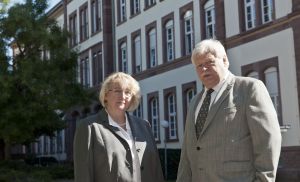Today, the Baden-Württemberg Minister of Science, Research, and the Arts, Theresia Bauer, paid her first visit to the Karlsruhe Institute of Technology (KIT). Apart from research projects on the future of energy supply and mobility, planned construction and renovation projects on Campus South were part of the program. KIT President Professor Horst Hippler additionally presented a new project to the Minister: The House of Participation studies new pathways of decision-making and democratic participation at KIT and in society.
“KIT is one of the model institutions in Baden-Württemberg and a model project in the best sense in the Federal Republic of Germany. I am impressed by the successes reached in research, education, and innovation by KIT in the past two years since its foundation. In energy research, KIT can make decisive contributions to the energy turnaround by innovations in electromobility and energy efficiency,” said the Minister. In her opinion, the House of Participation of KIT shows that KIT can identify new paths for the development of universities and civil society in other fields as well.
“In the coming years, KIT will face big challenges. To manage them successfully, we rely on a close cooperation with the Ministry of Science, Research, and the Arts (MWK). That is why we wish to present to the Minister the topics on which we are working presently and, of course, the entire premises of KIT,” said President Professor Horst Hippler. About 1100 scientists alone are conducting research for the energy mix in the future at more than 60 institutes of KIT. About 800 employees at nearly 40 institutes are working on concepts for the mobility of future generations. “With high commitment, our scientists wish to contribute to mastering the technical challenges,” emphasized Hippler.
Among others, the Minister visited the bioliq pilot plant and the ANKA synchrotron radiation source on KIT Campus North. bioliq has a project volume of about EUR 60 million. Its objective is the production of designer fuels from biomass. In the direct vicinity of the pilot plant, the planned Energy Lab will be constructed. Here, use of biomass material and energy will be studied. ANKA – an example of large scientific facilities on KIT Campus North – is a high-tech center for microfabrication and microanalysis that is open not only to KIT scientists. Users from all over Europe can analyze materials precisely using the ANKA synchrotron light.
The Minister also visited the new KIT Campus East on the former area of the Mackensen barracks. There, KIT scientists are developing energy-efficient, low-emission, and safe vehicles and mobility concepts.
A very young research project presented by the KIT President to the Minister is the House of Participation (HoP) on KIT’s Campus South. With funds granted by the state of Baden-Württemberg, it develops and studies new pathways of decision-making and democratic participation at KIT and in society by means of interdisciplinary approaches. KIT itself becomes a “living laboratory”, in which processes, tools, and techniques are applied in pilot studies for later transfer to other organizations.
Finally, the Minister informed herself about ongoing construction projects on the KIT premises. As the number of pupils with a university entrance certificate will double next year due to the reduction of secondary school duration by one year, KIT, like other universities, faces big challenges as regards room capacity. In order to create enough space for education, a new building with seminar rooms and laboratories is being constructed on KIT’s Campus South with state funding. In the direct vicinity of the Audimax, the Materials Science Center will be built. A new gymnasium is being constructed near the Institute of Sports and Sports Science. In parallel, extensive renovation projects are being conducted, among others the renovation of the Mathematics building and of the old Chemical Technology building on the Ehrenhof.
In close partnership with society, KIT develops solutions for urgent challenges – from climate change, energy transition and sustainable use of natural resources to artificial intelligence, sovereignty and an aging population. As The University in the Helmholtz Association, KIT unites scientific excellence from insight to application-driven research under one roof – and is thus in a unique position to drive this transformation. As a University of Excellence, KIT offers its more than 10,000 employees and 22,800 students outstanding opportunities to shape a sustainable and resilient future. KIT – Science for Impact.

